2013 CHRYSLER 300 oil level
[x] Cancel search: oil levelPage 320 of 592

•Oil Pressure Warning Telltale
This telltale indicates low engine oil pressure. If
the light turns on while driving, stop the vehicle and shut
off the engine as soon as possible. A chime will sound for
four minutes when this light turns on.
Do not operate the vehicle until the cause is corrected.
This light does not show how much oil is in the engine.
The engine oil level must be checked under the hood.
• Charging System Telltale
This telltale shows the status of the electrical
charging system. If the telltale stays on or comes
on while driving, turn off some of the vehicle’s non-
essential electrical devices or increase engine speed (if at
idle). If the charging system telltale remains on, it means
that the vehicle is experiencing a problem with the
charging system. Obtain SERVICE IMMEDIATELY. See
an authorized dealer. If jump starting is required, refer to “Jump Starting
Procedures” in “What To Do In Emergencies”.
•
Electronic Throttle Control (ETC) Telltale
This telltale informs you of a problem with the
Electronic Throttle Control (ETC) system. If the
telltale comes on while driving, have the sys-
tem checked by an authorized dealer.
If a problem is detected, the telltale will come on while
the engine is running. Cycle the ignition key when the
vehicle has completely stopped and the shift lever is
placed in the PARK position. The telltale should turn off.
If the telltale remains lit with the engine running, your
vehicle will usually be drivable. However, see an autho-
rized dealer for service as soon as possible. If the telltale
is flashing when the engine is running, immediate service
318 UNDERSTANDING YOUR INSTRUMENT PANEL
Page 503 of 592
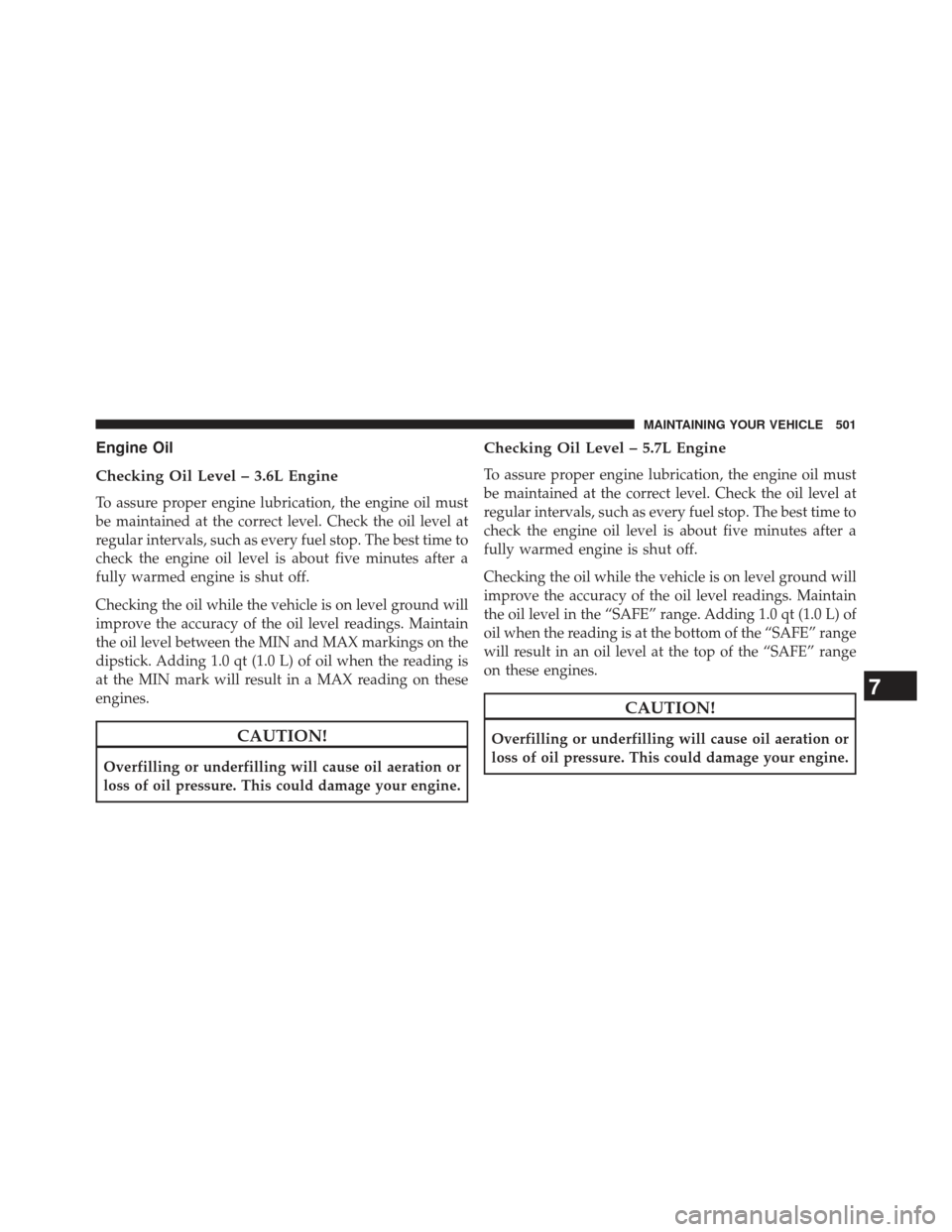
Engine Oil
Checking Oil Level – 3.6L Engine
To assure proper engine lubrication, the engine oil must
be maintained at the correct level. Check the oil level at
regular intervals, such as every fuel stop. The best time to
check the engine oil level is about five minutes after a
fully warmed engine is shut off.
Checking the oil while the vehicle is on level ground will
improve the accuracy of the oil level readings. Maintain
the oil level between the MIN and MAX markings on the
dipstick. Adding 1.0 qt (1.0 L) of oil when the reading is
at the MIN mark will result in a MAX reading on these
engines.
CAUTION!
Overfilling or underfilling will cause oil aeration or
loss of oil pressure. This could damage your engine.
Checking Oil Level – 5.7L Engine
To assure proper engine lubrication, the engine oil must
be maintained at the correct level. Check the oil level at
regular intervals, such as every fuel stop. The best time to
check the engine oil level is about five minutes after a
fully warmed engine is shut off.
Checking the oil while the vehicle is on level ground will
improve the accuracy of the oil level readings. Maintain
the oil level in the “SAFE” range. Adding 1.0 qt (1.0 L) of
oil when the reading is at the bottom of the “SAFE” range
will result in an oil level at the top of the “SAFE” range
on these engines.
CAUTION!
Overfilling or underfilling will cause oil aeration or
loss of oil pressure. This could damage your engine.
7
MAINTAINING YOUR VEHICLE 501
Page 526 of 592
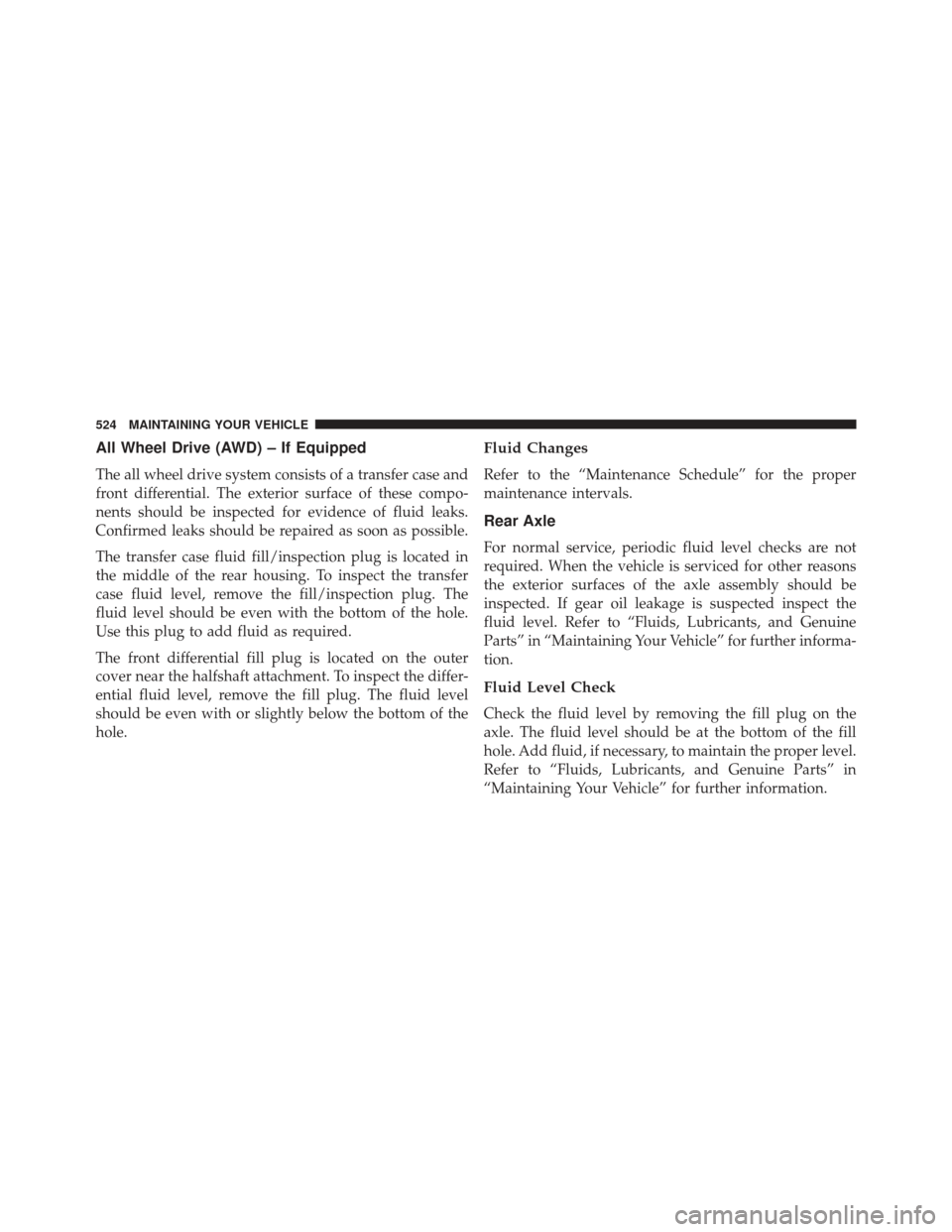
All Wheel Drive (AWD) – If Equipped
The all wheel drive system consists of a transfer case and
front differential. The exterior surface of these compo-
nents should be inspected for evidence of fluid leaks.
Confirmed leaks should be repaired as soon as possible.
The transfer case fluid fill/inspection plug is located in
the middle of the rear housing. To inspect the transfer
case fluid level, remove the fill/inspection plug. The
fluid level should be even with the bottom of the hole.
Use this plug to add fluid as required.
The front differential fill plug is located on the outer
cover near the halfshaft attachment. To inspect the differ-
ential fluid level, remove the fill plug. The fluid level
should be even with or slightly below the bottom of the
hole.
Fluid Changes
Refer to the “Maintenance Schedule” for the proper
maintenance intervals.
Rear Axle
For normal service, periodic fluid level checks are not
required. When the vehicle is serviced for other reasons
the exterior surfaces of the axle assembly should be
inspected. If gear oil leakage is suspected inspect the
fluid level. Refer to “Fluids, Lubricants, and Genuine
Parts” in “Maintaining Your Vehicle” for further informa-
tion.
Fluid Level Check
Check the fluid level by removing the fill plug on the
axle. The fluid level should be at the bottom of the fill
hole. Add fluid, if necessary, to maintain the proper level.
Refer to “Fluids, Lubricants, and Genuine Parts” in
“Maintaining Your Vehicle” for further information.
524 MAINTAINING YOUR VEHICLE
Page 549 of 592
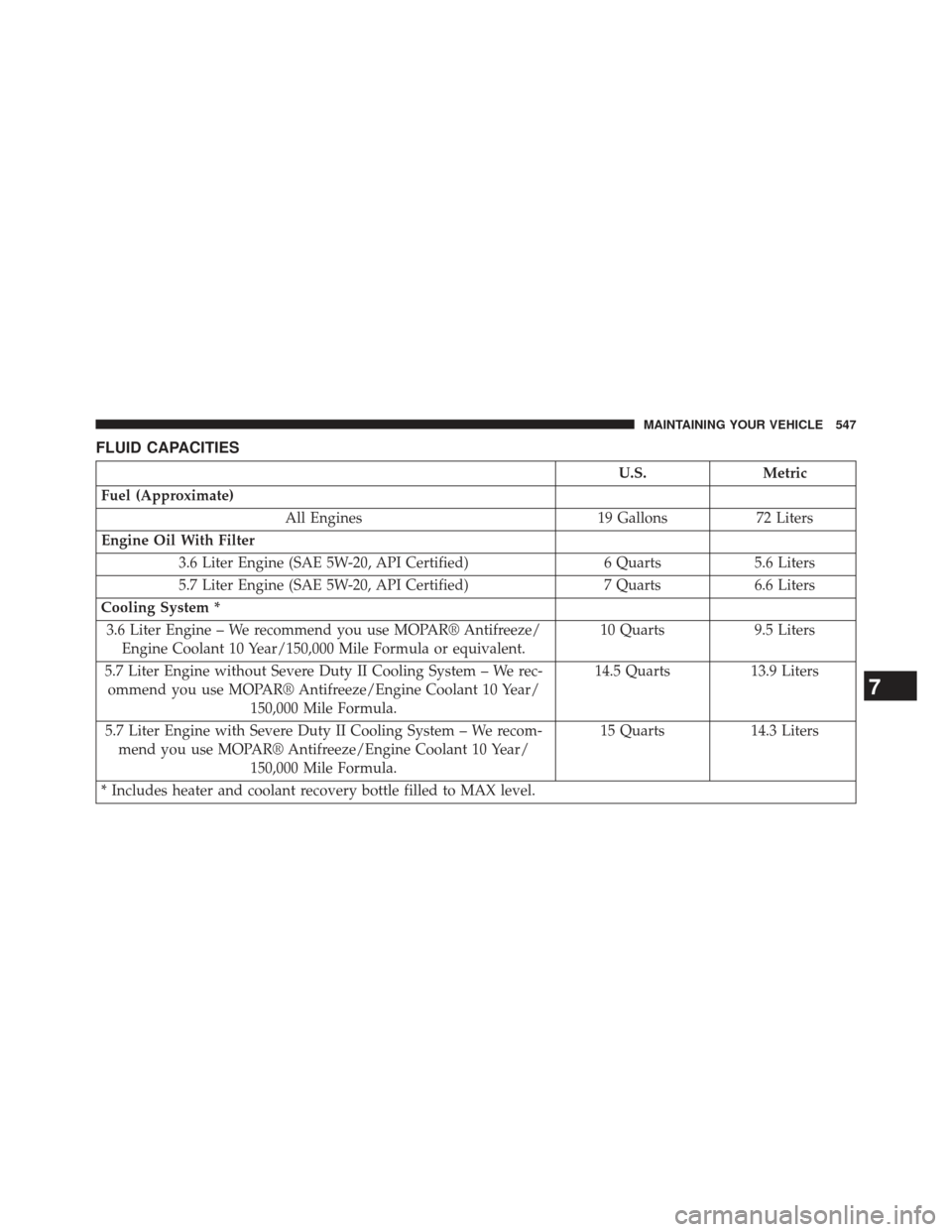
FLUID CAPACITIES
U.S.Metric
Fuel (Approximate) All Engines 19 Gallons72 Liters
Engine Oil With Filter 3.6 Liter Engine (SAE 5W-20, API Certified) 6 Quarts5.6 Liters
5.7 Liter Engine (SAE 5W-20, API Certified) 7 Quarts6.6 Liters
Cooling System * 3.6 Liter Engine – We recommend you use MOPAR® Antifreeze/ Engine Coolant 10 Year/150,000 Mile Formula or equivalent. 10 Quarts
9.5 Liters
5.7 Liter Engine without Severe Duty II Cooling System – We rec- ommend you use MOPAR® Antifreeze/Engine Coolant 10 Year/ 150,000 Mile Formula. 14.5 Quarts
13.9 Liters
5.7 Liter Engine with Severe Duty II Cooling System – We recom- mend you use MOPAR® Antifreeze/Engine Coolant 10 Year/ 150,000 Mile Formula. 15 Quarts
14.3 Liters
* Includes heater and coolant recovery bottle filled to MAX level.
7
MAINTAINING YOUR VEHICLE 547
Page 555 of 592
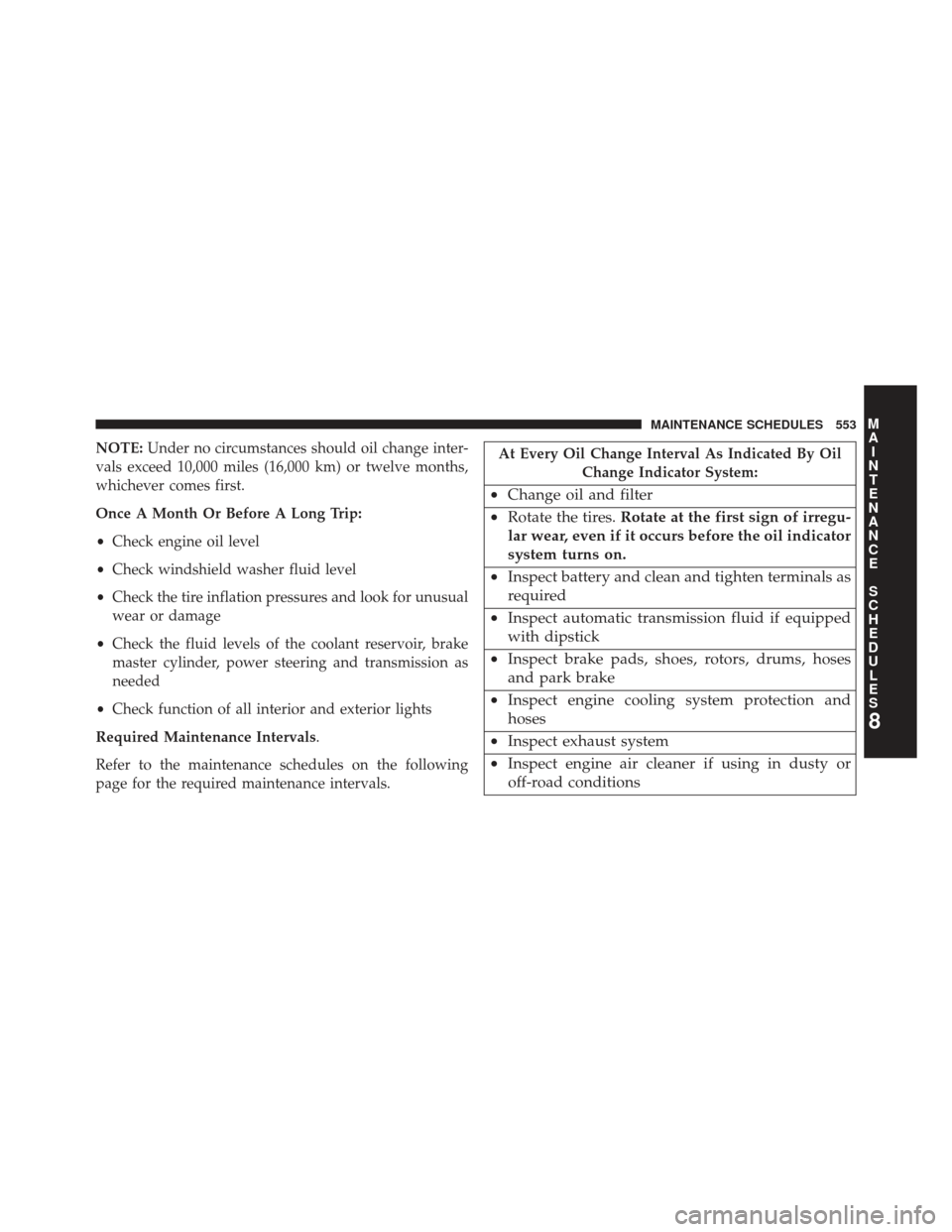
NOTE:Under no circumstances should oil change inter-
vals exceed 10,000 miles (16,000 km) or twelve months,
whichever comes first.
Once A Month Or Before A Long Trip:
• Check engine oil level
• Check windshield washer fluid level
• Check the tire inflation pressures and look for unusual
wear or damage
• Check the fluid levels of the coolant reservoir, brake
master cylinder, power steering and transmission as
needed
• Check function of all interior and exterior lights
Required Maintenance Intervals.
Refer to the maintenance schedules on the following
page for the required maintenance intervals.At Every Oil Change Interval As Indicated By Oil Change Indicator System:
•Change oil and filter
• Rotate the tires. Rotate at the first sign of irregu-
lar wear, even if it occurs before the oil indicator
system turns on.
• Inspect battery and clean and tighten terminals as
required
• Inspect automatic transmission fluid if equipped
with dipstick
• Inspect brake pads, shoes, rotors, drums, hoses
and park brake
• Inspect engine cooling system protection and
hoses
• Inspect exhaust system
• Inspect engine air cleaner if using in dusty or
off-road conditions
8
M
A I
N T
E
N
A
N
C E
S
C
H E
D
U L
E
SMAINTENANCE SCHEDULES 553
Page 575 of 592
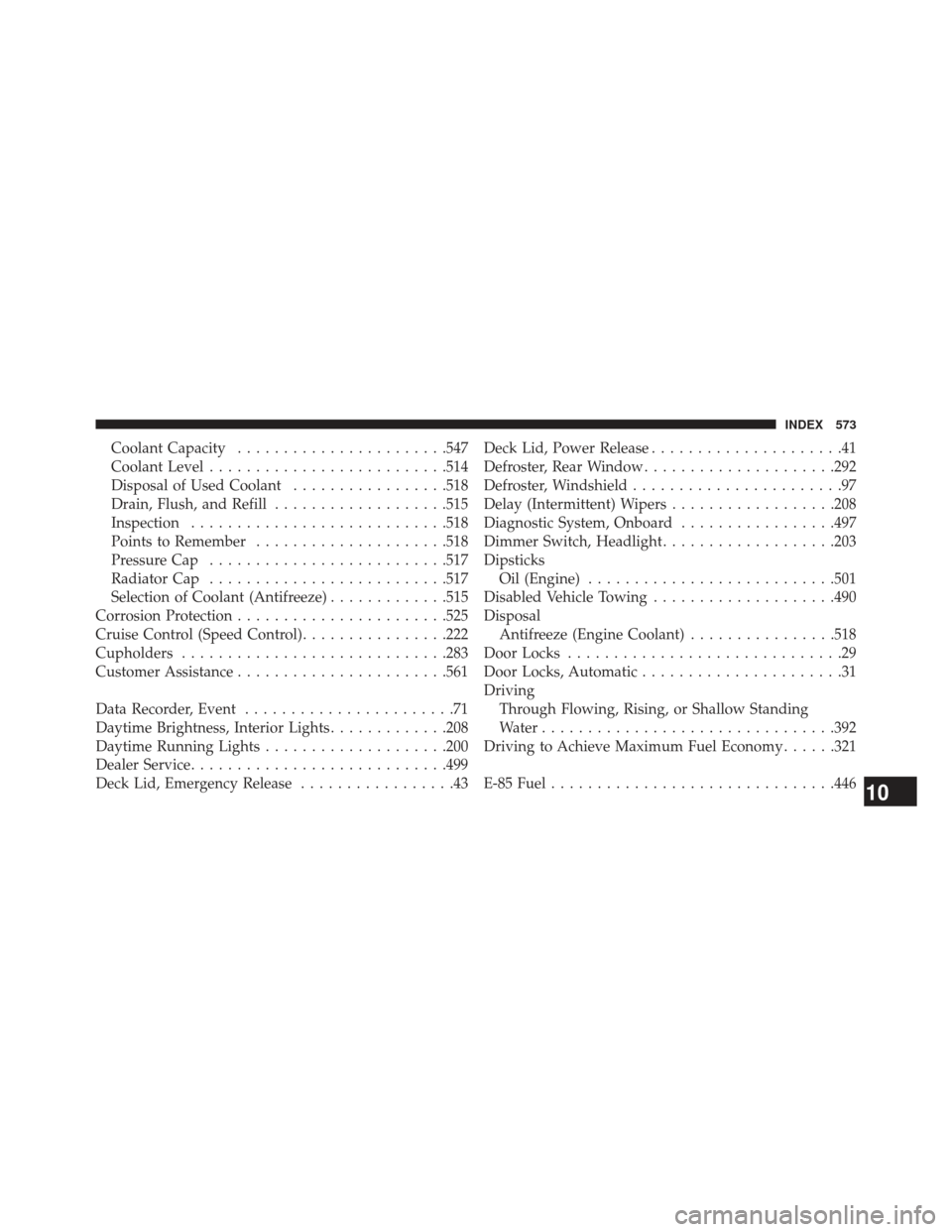
Coolant Capacity...................... .547
Coolant Level ......................... .514
Disposal of Used Coolant .................518
Drain, Flush, and Refill ...................515
Inspection ........................... .518
Points to Remember .....................518
Pressure Cap ......................... .517
Radiator Cap ......................... .517
Selection of Coolant (Antifreeze) .............515
Corrosion Protection ...................... .525
Cruise Control (Speed Control) ................222
Cupholders ............................ .283
Customer Assistance ...................... .561
Data Recorder, Event .......................71
Daytime Brightness, Interior Lights .............208
Daytime Running Lights ....................200
Dealer Service ........................... .499
Deck Lid, Emergency Release .................43Deck Lid, Power Release
.....................41
Defroster, Rear Window .....................292
Defroster, Windshield .......................97
Delay (Intermittent) Wipers ..................208
Diagnostic System, Onboard .................497
Dimmer Switch, Headlight ...................203
Dipsticks Oil (Engine) .......................... .501
Disabled Vehicle Towing ....................490
Disposal Antifreeze (Engine Coolant) ................518
Door Locks ..............................29
Door Locks, Automatic ......................31
Driving Through Flowing, Rising, or Shallow Standing
Water ............................... .392
Driving to Achieve Maximum Fuel Economy ......321
E-85 Fuel .............................. .446
10
INDEX 573
Page 576 of 592
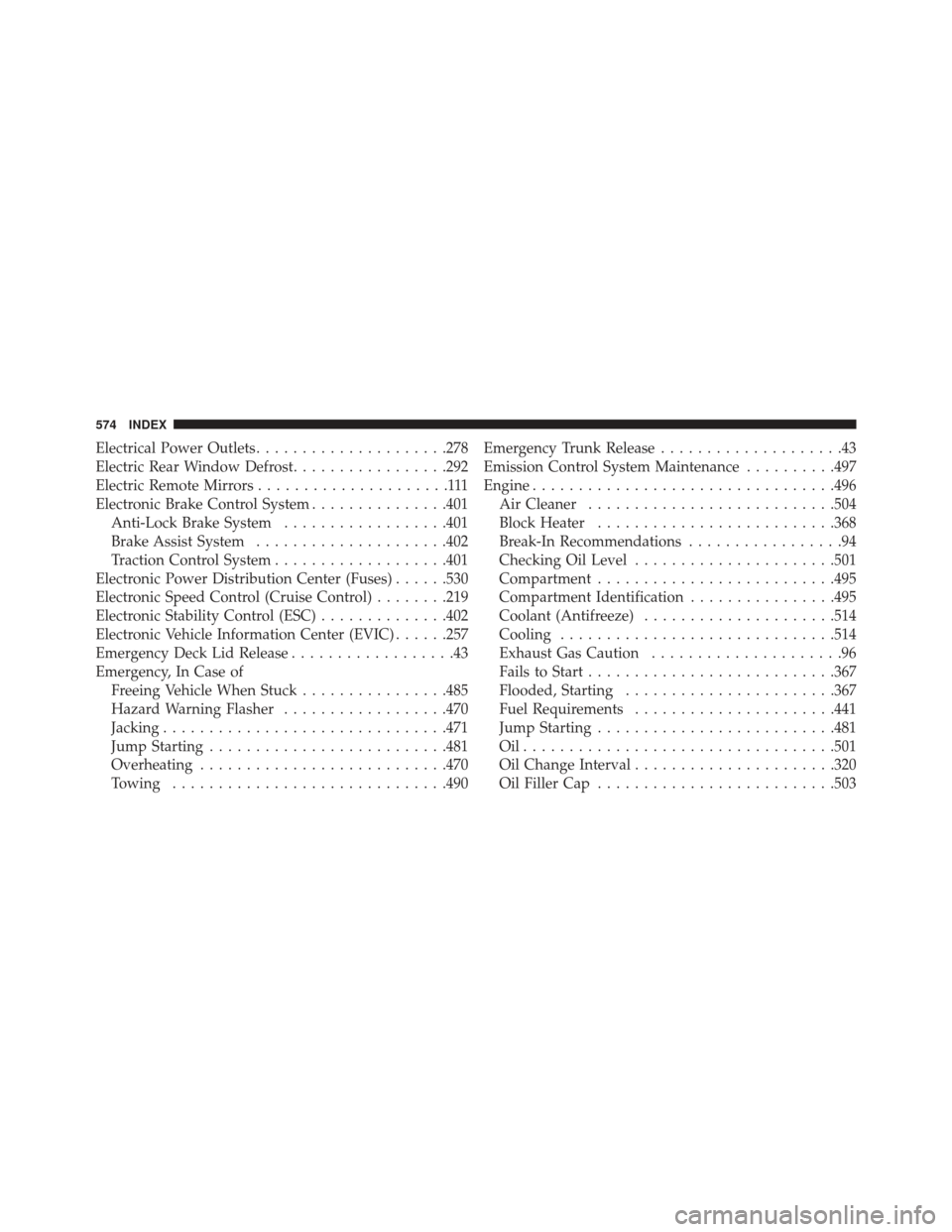
Electrical Power Outlets.....................278
Electric Rear Window Defrost .................292
Electric Remote Mirrors .....................111
Electronic Brake Control System ...............401
Anti-Lock Brake System ..................401
Brake Assist System .....................402
Traction Control System ...................401
Electronic Power Distribution Center (Fuses) ......530
Electronic Speed Control (Cruise Control) ........219
Electronic Stability Control (ESC) ..............402
Electronic Vehicle Information Center (EVIC) ......257
Emergency Deck Lid Release ..................43
Emergency, In Case of Freeing Vehicle When Stuck ................485
Hazard Warning Flasher ..................470
Jacking .............................. .471
Jump Starting ......................... .481
Overheating .......................... .470
Towing ............................. .490Emergency Trunk Release
....................43
Emission Control System Maintenance ..........497
Engine ................................ .496
Air Cleaner .......................... .504
Block Heater ......................... .368
Break-In Recommendations .................94
Checking Oil Level ..................... .501
Compartment ......................... .495
Compartment Identification ................495
Coolant (Antifreeze) .....................514
Cooling ............................. .514
Exhaust Gas Caution .....................96
Fails to Start .......................... .367
Flooded, Starting ...................... .367
Fuel Requirements ..................... .441
Jump Starting ......................... .481
Oil................................. .501
Oil Change Interval ..................... .320
Oil
Filler Cap ......................... .503
574 INDEX
Page 578 of 592
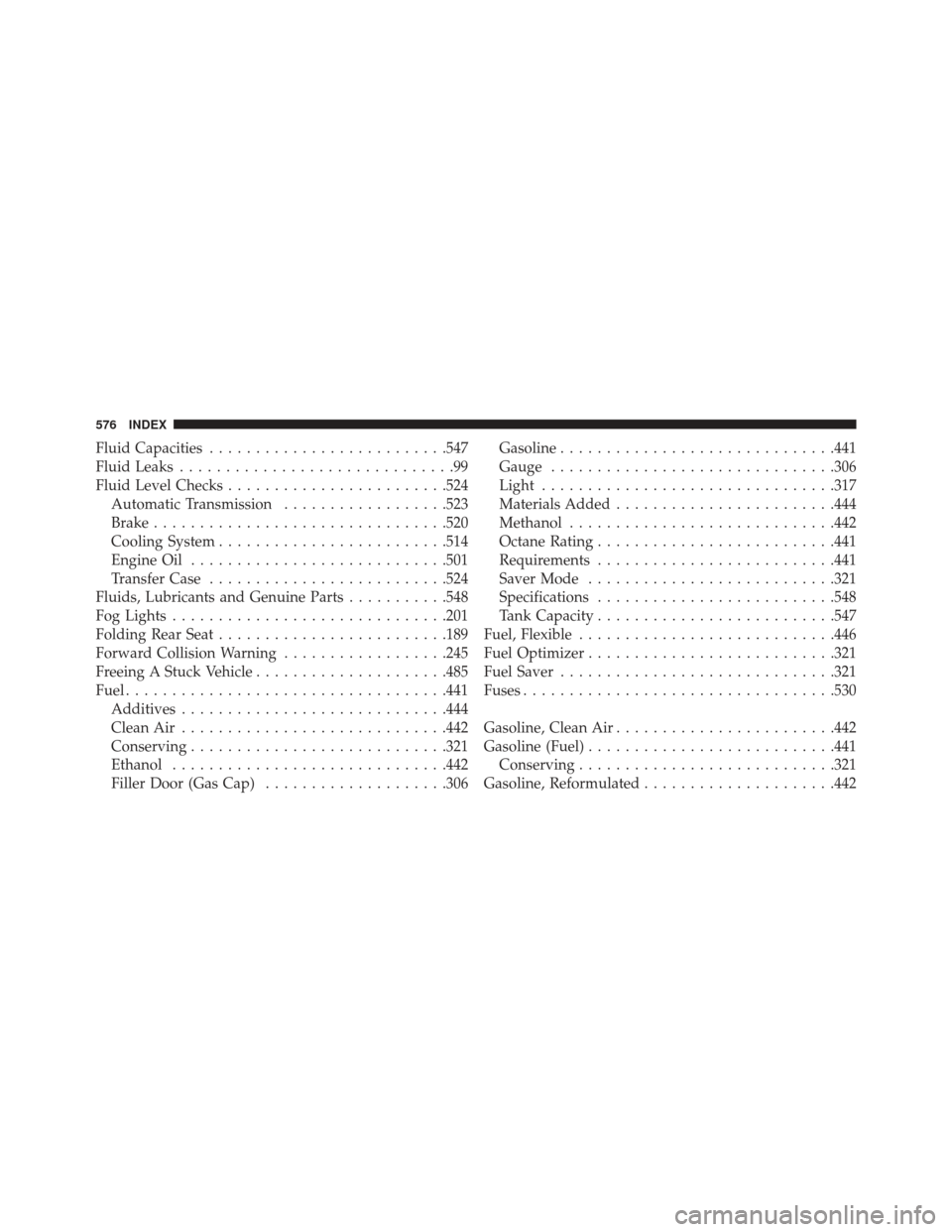
Fluid Capacities......................... .547
Fluid Leaks ..............................99
Fluid Level Checks ....................... .524
Automatic Transmission ..................523
Brake ............................... .520
Cooling System ........................ .514
Engine Oil ........................... .501
Transfer Case ......................... .524
Fluids, Lubricants and Genuine Parts ...........548
Fog Lights ............................. .201
Folding Rear Seat ........................ .189
Forward Collision Warning ..................245
Freeing A Stuck Vehicle .....................485
Fuel .................................. .441
Additives ............................ .444
Clean Air ............................ .442
Conserving ........................... .321
Ethanol ............................. .442
Filler Door (Gas Cap) ....................306 Gasoline
............................. .441
Gauge .............................. .306
Light ............................... .317
Materials Added ....................... .444
Methanol ............................ .442
Octane Rating ......................... .441
Requirements ......................... .441
Saver Mode .......................... .321
Specifications ......................... .548
Tank Capacity ......................... .547
Fuel, Flexible ........................... .446
Fuel Optimizer .......................... .321
Fuel Saver ............................. .321
Fuses ................................. .530
Gasoline, Clean Air ....................... .442
Gasoline (Fuel) .......................... .441
Conserving ........................... .321
Gasoline,
Reformulated .....................442
576 INDEX